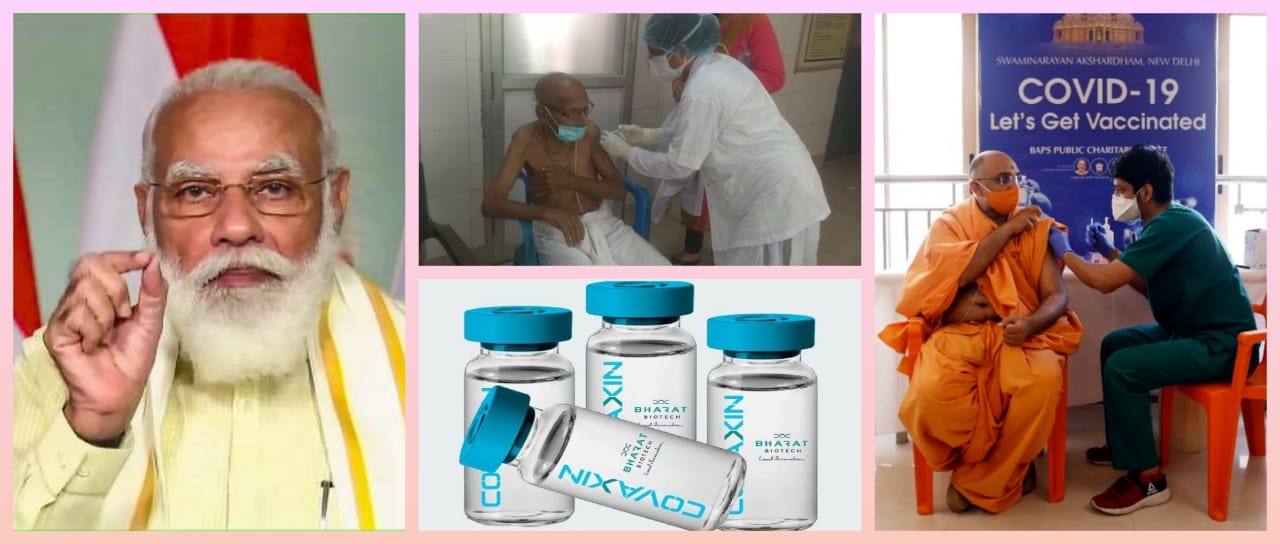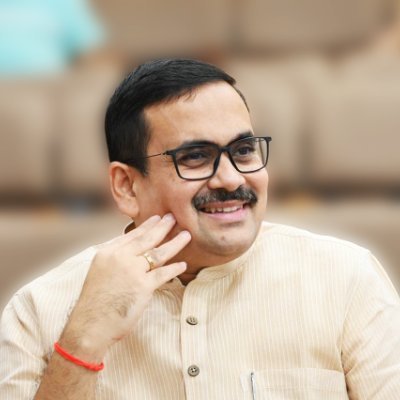23 crore Covid vaccine doses have been administered in India. This is a major landmark achieved by the Narendra Modi government in its herculean effort to stem and control the pandemic’s second outbreak. The world’s largest vaccination drive is gathering pace and momentum and the Modi government is ensuring that there is ramped up production and enhanced supply across states.
Since last year (2020), Prime Minister spoke ceaselessly of the need to remain alert, to follow all Covid related protocols and to wait for vaccine to be rolled out and administered. When the vaccine came and was put into use, PM repeatedly called upon and encouraged people to come forward and to take the vaccine. Age and service criteria were worked out for administering the vaccine to the first batches – comprising of frontline workers and the very vulnerable.
But the approach and attitude of the opposition parties, led by the Congress and some regional parties, stood in opposition to this nation-wide vaccination drive. These parties and their leaders have repeatedly displayed an irresponsible attitude to this national effort. A personalised politics, an irrational antipathy to PM Modi and his efforts by these parties, created a negative narrative not only on India’s vaccination drive, but also on India’s efforts to produce vaccines. This negative propaganda gave, rise among some sections, to ‘vaccine hesitancy’.
If sections of the population did not want to be inoculated, if they were seen to be refusing vaccination and to be doubting India’s capacity to produce and administer the vaccine it was because of this ‘vaccine hesitancy’ stance promoted by a section of the political opposition in India. The opposition’s stance exposed the vulnerable sections to Covid infection risk, dented the vaccination drive and led to definite vaccine wastage. Having done this, it was also ironical to see many of these leaders take the jab later. But by then their irresponsible utterances had already impacted negatively the drive.
On 16th January 2021, when the world’s largest vaccination drive was launched in India, by PM Modi, it generated hope, optimism and relief among people. But Congress leader Manish Tewari, for instance, publicly criticised the drive and questioned the efficacy of the vaccine. Soon other opposition leaders joined the chorus in opposing the drive and the vaccine, thus sowing seeds of doubt in the minds of millions. Health Minister of Congress ruled Chhattisgarh, T.S. Singhdeo, for example, opposed the use of Covaxin, which PM Modi himself and many others had taken. Singhdeo said that the vaccine was ‘NOT SAFE.’ He repeatedly indulged in fear-mongering and began discrediting Indian-made vaccines. Later though, Singhdeo got himself inoculated with Covaxin having spread fear and doubt against it.
One would have expected a former Chief Minister of one the largest states of India, Uttar Pradesh, to display a modicum of sense and commitment to public welfare and national health, but instead of that Akhilesh Yadav of the Samajwadi Party, former Chief Minister of Uttar Pradesh, took the lead in generating vaccine hesitancy. In a callous and motivated stance, Akhilesh declared that the BJP’s vaccine could not be trusted, ‘we cannot get vaccinated by BJP’s vaccine.’
Prime Minister Modi, took his first jab in March 2021, only after frontline workers had taken the vaccine. In January, Nawab Malik, spokesperson of the regional Nationalist Congress Party (NCP) had made fun of the Prime Minister for not taking the vaccine, saying, that people harboured doubts about the upcoming vaccination drive and that ‘Prime Minister Narendra Modi should get himself inoculated first to allay their concern…” Malik was deliberately obfuscating the fact that the Prime Minister had repeatedly said, that the vaccine plan had clearly indicated that priority would be given to frontline workers and only then would the Prime Minister and others take it.
Health Minister in the JMM government of Jharkhand, Banna Gupta, deliberately spread vaccine hesitancy among people saying that people of India should not be made ‘lab rats.’ He said this after India had announced its universal vaccination drive. A section of the intelligentsia and commentariat led by the likes of Supreme Court lawyer Prashant Bhushan even doubted the need for a vaccine. To the Modi government’s announcement that 35,000 crores would be pumped in for the Covid vaccine, Bhushan questioned the need to give this money for producing vaccines when ‘Covid is naturally dying down in India.’
The level of the discourse dipped to an all-time low when Asaduddin Owaisi, leader of the Muslim political party AIMIM asked, making light of the entire exercise, that he had read in a report emanating from the West that Covishield is not effective and that is why the Prime Minister had taken the Covaxin doze. West Bengal Chief Minister Mamata Banerjee had publicly cast aspersion on the entire vaccine producing exercise, and had raised questions on the efficacy of the vaccines. Thus, for over a sustained period, leaders of these parties, publicly promoted vaccine hesitancy, generating confusion, doubt and uncertainty. While the fact that India had rolled out the world’s largest vaccination drive could have been an occasion to disseminate the message of an India that was confident and certain of recovery, here was a political section, driven by a compulsive need to oppose Modi, deliberately pushing a segment of the population to the brink as far as the Covid challenge was concerned.
To add to this was their continuously shifting stance on procurement and distribution. The Congress and regional parties such as the Trinamool Congress first called for giving rights to the states for the procurement and distribution of vaccines. Leaders such as Rahul Gandhi, Arvind Kejriwal and Mamata Banerjee had made the demand. But as soon as power was delegated to them, these parties got together to demand that the Union government must procure vaccines and give it to the states. In fact, Chief Ministers of Congress ruled states wrote to the Prime Minister calling for ‘centralised procurement of vaccines’ and on June 7th just after PM Modi announced ‘a centralised vaccine drive’ which will be wholly supported and borne by his government, Mamata Banerjee complained that Modi would take away all credit and the Congress lamented that universal free vaccine was still not achieved.
Undeterred by these motivated ellipses, PM Modi announced that his government will procure 75 per cent of the vaccines that were being produced in the country and also procure the 25 per cent of the vaccines that were to be undertaken by the states. While the opposition to Modi opposed the vaccination drive, sought to sow confusion, panic and hesitancy among people and raise hurdles to slow the drive or to derail it, PM Modi displayed a stoic focus and doggedness on making the drive successful by enhancing its speed and widening its reach. Every-time he came up with an innovative approach which would help in transforming the drive to a peoples’ movement.
Launching the nation-wide ‘Tika Utsav’ (Vaccine Festival) in the middle of April 2021, a mega drive to push for greater vaccination and awareness of it, PM Modi spoke of this as the beginning of a ‘second major war against corona’. This was an inspiring and innovate approach to spread societal awareness on the imperative for vaccination and also to turn it into a drive which will heighten social consciousness and commitment. PM Modi spoke of four approaches:
First, Each One- Vaccinate, meaning those who can’t go themselves for vaccination such as the old and unaware, need to be assisted
Second, Each One- Treat One. This involves helping people in getting Corona treatment, who do not have resources or knowledge to get it.
Third, Each One- Save One, meaning I should wear mask and save myself and others.
Fourth, Society and people should lead in creating micro-containment zones.
Today, there is a visible confidence and pattern that is now setting-in in the Modi Government’s vaccine policy and drive. Increasing vaccination and a comprehensive roadmap clearly indicates that the hesitancy narrative is gradually losing steam and credibility. But those leaders and parties who generated hesitancy, need to ask themselves hard questions: why is it that they decided to endanger and place at risk the people of India, why is it that even in these times of a ‘once in a century’ pandemic, when India faces one of the severest national challenges since independence, they were incapable of placing a moratorium on their anti-Modi politics and join in lifting India out of this complex web? While Modi is driven by India-First, the opposition to him is deterred by it. Their promotion of vaccine hesitancy was a failed attempt to jettison India’s rise.
(The writer is the Director of Dr Syama Prasad Mookerjee Research Foundation. Views expressed are personal)
Image Source: https://bsmedia.business-standard.com
(The views expressed are the author's own and do not necessarily reflect the position of the organisation)


